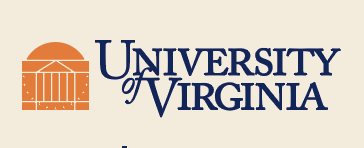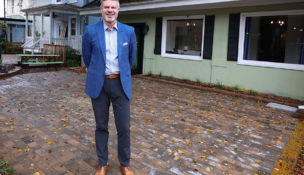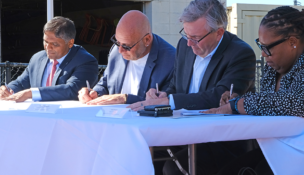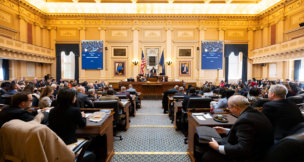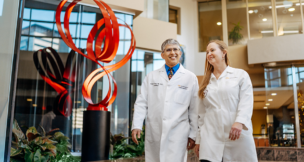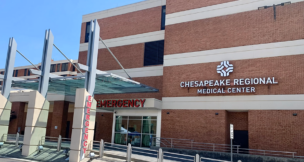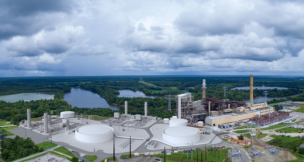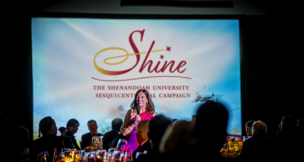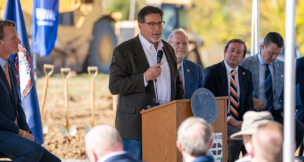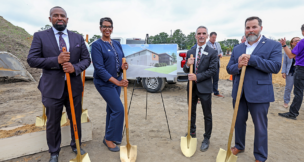Betting on biotech
U.Va. institute may lead to research boom
Virginians have often sought experimental medical treatments outside the state — traveling to North Carolina, Boston or one of the Mayo Clinic’s locations. However, the Paul and Diane Manning Institute of Biotechnology at the University of Virginia aims to change that.
“We intend to tackle the biggest challenges in health care and to empower our researchers to make the life-changing breakthroughs that will transform care for people across Virginia and beyond,” says Dr. K. Craig Kent, CEO of UVA Health and executive vice president for health affairs at U.Va. “We’re on a cusp of a revolution in health care.”
Construction of the institute, which will be built in the 54-acre Fontaine Research Park adjacent to U.Va.’s Grounds, is set to be complete in 2026 or 2027. However, the university is forging ahead with hires, including about 100 scientists who will research potential treatments for diseases like diabetes and Alzheimer’s. Kent anticipates employing 1,000 to 1,400 people at the institute, which will include 30,000 to 40,000 square feet of lab space and a biomanufacturing facility.
The institute will expand U.Va.’s existing research operations and position the school at the forefront of areas of modern medical research, such as gene therapy and nanotechnology. Also among the institute’s principal focuses are cellular therapy and targeted drug delivery, which help patients get well faster and with less physical pain compared with chemotherapy and radiation treatments for cancer.
Charlottesville biotech investor Paul B. Manning and his wife, Diane, are the chief engineers behind the institute; they made a $100 million gift to the university to start it, and Paul Manning was instrumental in getting the Virginia General Assembly’s support for the institute in 2022. In addition to the Mannings’ donation, U.Va. will provide $150 million for the institute, and the state is contributing $50 million.
That’s a lot of activity for U.Va., but Kent and others expect the institute will also have a big commercial impact in Charlottesville and its surroundings, possibly rippling out to other parts of the state, as biotech companies move to the region or expand their operations in response to the institute and its work.
John Newby, CEO of Virginia Bio, a nonprofit trade association for the life sciences industry, says the state’s investment in the U.Va. biotech institute is one of several signs that Virginia is serious about supporting biotech. Other recent investments by the state include $15 million for laboratory space in Roanoke and $15 million for new lab space for the nascent pharmaceutical manufacturing cluster developing in Richmond and Petersburg.
“I think what’s happening in U.Va. is fantastic. It’s going to be a major, major boon, not just to the Charlottesville area but to the entire state,” Newby says, adding that the institute could help the commonwealth stand out in a competitive market.
“We are sandwiched between Maryland and the [Interstate] 270 corridor and [the Research Triangle Park] down in North Carolina,” he says. “We’re physically located between those two biotechnology hubs. I think that these activities will help us distinguish ourselves from those areas and attract more people to Virginia.”
Burst of activity
In Charlottesville, the institute could bolster a bioscience cluster of about 3,000 employees and 75 companies, according to Chris Engel, director of economic development for Charlottesville. He says challenges the developing sector faces include attracting talent and laboratory space, which U.Va.’s institute could address.
“Just having that activity will thereby kind of make Charlottesville a more attractive place for other companies to want to be,” he says. “Everybody’s cautiously optimistic that it’s going to be beneficial for the region.”
There has been a perception that the Charlottesville region needed an anchor, such as a large pharmaceutical company, to bring jobs and opportunities that would allow Charlottesville to compete with regions in other states steeped in research, says Nikki Hastings, co-founder and executive director of CvilleBioHub, a Charlottesville-based nonprofit organization that aims to boost the number of biotech businesses in the area.
One of CvilleBioHub’s goals is to double the size of the region’s biotech industry by 2030, which would call for about 50 new companies, Hastings says, but she expects that goal will be easily met.
“I think we will exceed that doubling,” she says. “What we are seeing here [is] companies funded by venture capital at both increasing frequencies and increasing sizes of rounds.”
Hastings, who has a Ph.D. in biomedical engineering from U.Va. and is an experienced investor in biotech startups, says she’s seen a major boost in interest in the Charlottesville area since January, when the institute was announced.
“There’s been a lot of great momentum here,” she says. “There’s just been a lot of visibility and promotional activity around it that I think people are now looking to Charlottesville and saying, ‘Oh, what else is going on here?’”
Kent also expects the economic impact will be “fairly substantial. I think by the time the building opens, we’ll have a very vibrant and robust program already in place that will just transfer it into the building and continue to recruit.”

One of the goals of the institute is that good ideas — developed by scientists at U.Va., Virginia Tech, Virginia Commonwealth University and elsewhere in the state — don’t get lost in “translation,” he adds. In biotech, that term describes when an idea or concept moves from research to the manufacturing stage, ultimately bound for commercialization. Presently, some projects developed at state schools may stall when reaching this phase, as local capacity for manufacturing pharmaceutical treatments is lacking. Many medications are produced outside Virginia.
“And then it never comes back,” Kent says. “We want to be able to be the epicenter for translation at other universities across the state. We hope as this grows, that we can develop some really solid partnerships with VCU, Virginia Tech and some of the other schools around the state where there is interest in this more translational type of work.”
New science
When U.Va. President James E. Ryan, a legal scholar and former Harvard Graduate School of Education dean, began his tenure leading U.Va. in 2018, advances in biotechnology weren’t on his radar.
“I didn’t know that much about this until about a year or so ago, but I’ve learned a decent amount,” he says. “I really feel like we’re in the midst of a revolution about how we treat diseases, especially diseases that have been incurable or are difficult to treat. This institute is going to follow in that path and focus on cutting-edge therapies that hopefully will allow us to treat diseases that we can’t [currently] treat.”
The institute’s future research will build on the work of scientists who are already at the school and have created one of the largest research portfolios in Virginia, while establishing a footprint at the university in the “translational field,” converting research into bedside treatments, Ryan says. These practical implementations are what he finds exciting.
“For example, instead of … [administering] general chemotherapy, which can be pretty destructive, you’re taking a much more precise approach, and using someone’s own cells to actually attack the disease,” he says, describing genetic therapies for cancer. “It opens up so many different possibilities about diseases that we have largely given up on being able to cure, and I think we’re really just at the very beginning. I’m excited that U.Va.’s going to be part of it.”
While the narrative of the institute might be “announce it and they will come,” there’s still a lot of work to be done before the opening of the physical building, which is still in the architectural planning stages. The original plans for the institute called for a 350,000-square-foot building, but inflation and other issues impacting construction have led to a reconsideration of its final form. U.Va. had not yet hired a general contractor as of early April, but had chosen an architect, Elkus Manfredi Architects of Boston.
“We haven’t made a decision yet, but I think it’s fair to say it’ll be a fairly sizable building to be able to accommodate … many researchers,” Kent says. Some are already being hired and are working in existing buildings at U.Va., which has about 7,500 square feet dedicated to biotech manufacturing.
Work is underway
For one of the scientists who was recently hired to work at the institute, work has already begun. Researcher Jianjie Ma, the William H. Muller endowed professor of surgery at U.Va.’s medical school, secured two National Institutes of Health grants in October 2022 totaling $6.4 million to study muscle aging and Alzheimer’s disease in separate studies over the next five years.
He’s also working on a new treatment to help people with Type 2 diabetes. “The cost of treating diabetes in the state of Virginia every year [is] $8.4 billion,” Ma says. His treatment helps produce a molecule present in muscles that helps improve glucose levels.
Doctors frequently recommend physical activity to boost glucose levels in some diabetes patients, but Ma notes that “people with diabetes [often] don’t want to exercise because of rigidity or lack of energy.”
Ma says his treatment would potentially “replace exercise,” and is an example of how ideas can be converted into treatments at the biotech institute in the future.
A plan is in the works to create a statewide network for clinical trials of treatments like this, one of the final steps toward commercial release of medical treatments. This would happen through affiliations between UVA Health and other health systems in the state, and would allow people in other parts of the state to benefit from experimental treatments.
“We’re excited about the idea that all these new ideas [and] therapies will be available here to the people of the state of Virginia firsthand. And they won’t have to wait years for these therapies to be FDA-approved and then become available nationwide or internationally,” Kent says.
“We feel we have the ability to create [a] clinical trials network where we have sites at various locations throughout the state, so that these new trials can be available to people [statewide], not just in Charlottesville. … Our goal with all of this, and a lot of the work that we’re doing at UVA Health, is to create an environment where nobody should ever need to leave Virginia for their care.”
Virginia Business Deputy Editor Kate Andrews contributed to this story.
 At a glance
At a glance
Founded
Sometimes called Mr. Jefferson’s university or just The University, U.Va. was founded by Thomas Jefferson in 1819. Its first board of visitors included Jefferson and fellow U.S. Presidents James Madison and James Monroe.
Campus
With roughly 1,240 contiguous acres around its UNESCO World Heritage Site campus or “Grounds,” U.Va. is known for its distinctive Jefferson-designed Rotunda building located on The Lawn, the school’s 4.5-acre grass quad where graduations are held. U.Va.’s other major holding is the University of Virginia’s College at Wise, a four-year liberal arts college in Southwest Virginia.
Enrollment
16,793 undergraduate students
6,928 graduate students
2,466 international students
33% minority enrollment
68% in-state undergraduate students
Employees
Approximately 4,300 faculty, 16,300 staff and 12,700 UVA Health staff
Academic programs
Notable for its medicine, law and business schools, U.Va. offers more than 120 majors across 12 schools.
Tuition, fees, housing and dining*
Includes average room and board, plus books and other expenses.
In-state residents: $20,330
Out-of-state residents: $55,902
*Note: Costs are for first-year students and may differ depending on year and academic program.
s


